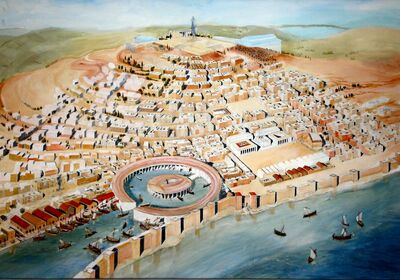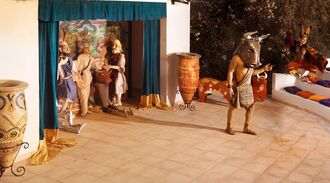Geo-economic Overview[]
Kythios is located on an island created by the two rivers and the Southern Ocean. The rivers are the Little Zerxos and the Greater Zerxos, which divide as they approach the sea, which is some 10 miles south of Kythios.
The strategic location of the city has been the key to the survival of Kythian civilisation, both for a trading-state and from a military perspective. Kythians have developed a strong navy to protect both their city and their trading interests, and also have a reliance on fishing.
Kythia is bordered by Leaberos to the west, Tygion to the north-west, the Helian Empire to the north and the Kingdom of Voth to the east.

Kythios
Kythians subsist on agriculture and fishing, with the principle crops being rice, wheat and pulses. Fruit and vines are also important, yielding wine and lambic wheat beers that Kythians are very fond-of.
Technology[]
Humani consider themselves the most technically advanced of the known races. By our standards they are still very primitive. Bronze is the king of metals, pottery is coiled and molded by hand, the bow-lathe is used to turn wood. Irrigation is assisted by networks of tanks and ditches constructed between the Little and Greater Zerxos. The chariot is the WMD of the age. Single-mast square-rigged ships ply the waves, and the galley is the navies' principle battleship. Humani are good with stone; embankments protect the city and magnificent stone buildings, some three stories high, grace Temple Hill. However, most dwellings are single-story mud-brick houses with pan-tile roofing, faced with plaster to resist the rains. Even the city walls are only stone-clad, with a timber-frame & earth core.

Art and Culture[]
Philosophy is the highest expression of intellectual endeavor in the New States, and Kythians are enthusiastic contributors, and several of the great philosophers hail from the city. Music, song, dance, theatre and poetry are also popular, and many entertainments consist of all of these. Theatre usually involves a narrator weaving a tale, and masked performers in colorful costumes miming the scenes with musical accompaniment.


Sculpture is popular, and Kythians are also fond of decorating their homes and pottery with geometric designs.
Government[]
Kythios is one of the New States, and as such is a democracy. The seat of government is the Demos, effectively an arena with a roof on Temple Hill. All key decisions are made here, by anyone who fancies turning up. In reality, it is dominated by key factions of important people within the city, but all adult citizens have a right to vote. Civil functions are managed by a council of elected officials called the Assembly. The Assembly elects three people each year as joint leaders.
Local Government[]
The city is divided into areas known as Hets. Each area has a Hettis, if male, or Hetta, if female who is responsible for ensuring thast order is maintained, taxes are paid, streets are cleaned and infrastructure is kept in good repair.


The Demos
This person is elected by the adult residents for life, or until they can no longer carry out their duties. Each of these officials sits on the Assembly.
Law and Order[]
Kythios has no coherent code of laws. This has not been helped by the lack of a written language. A wall of pictograms on Temple Hill in front of the Demos outlines a basic list of crimes and punishments, but these are more of a guideline, despite being actually written in stone. Also, there is no police force, judiciary or lawyers. If you have a grievance against someone, you bring them before your Hettis and he adjudicates. If either party is dissatisfied it can be brought before the Demos. Generally both sides have a chance to speak, and can call others to speak on their behalf, of against the other party. The gathered assembly then votes on the outcome and agrees upon any appropriate punishment or compensation.
Social Structure[]
Family is everything. Everyone is identified by what family they belong to. The nose-ring worn by every adult and pendant worn by every child has a unique design associated with their kin. Families live and work together, pool their incomes and share their debts and duties. Homes are inhabited by extended family groups living communally, typically with a single open living area with a central cooking-pit. Small rooms and cubicles are shared by adults, with children bedding down in the communal area. Family business and work is often carried out in the communal area, or an adjacent yard. Very large families tend occupy properties in close proximity. Bringing shame on the family is a serious transgression. Severe antisocial or criminal behavior can result in being an outcast, and living as an outcast can be extremely harsh.
Money[]
Kythios has a thriving cash economy based on copper, silver and gold coinage. There are two copper coins the smallest denomination is the Potin with the larger Follis being worth 3 Potins. Next are the silver coins, the Stater, worth 20 Potins and the Half-Stater. The most valuable coin is the gold Daric, worth 10 Staters, or 200 Potins.
Military[]
The Kythian Military consists of a small cadre of professional soldiers and sailors supported by a number of part-timers, and a militia. It is headed by elected senior officers. In time of war, the Demos elect a war council, to whom the Generals report. Kythians are famed for their fleet of Galleys, and their horse-archers, which they use in preference to chariots favored by other armed forces.

Kythian Fleetman

Kythian Falcater

Kythian Landsman

Kythian Kushra
The bulk of the army is made up of Landsmen, each carrying a long spear and a side-arm, usually a leaf-bladed bronze sword. These operate as a phalanx. The Landsmen are supported by Falcaters, heavy skirmishers who protect the flanks of the phalanx and exploit any weaknesses in enemy formations and are armed with either falchions or war-scythes. Fleetmen act as vanguards, scouts and skirmishers, carrying javelins and a sword as a side-arm. All the infantry types carry a large plywood shield, reinforced with bronze and having a characteristic crescent shaped section cut into the diameter, peculiar to Kythian troops.They are also equipped with a bronze helmet with a tall forward-curving peak. Archers are equipped similarly to Fleetmen, but carrying a compsite re-curve bow in place of the spears. There are two cavalry arms in the Kythian army, light horse-archers, called Kushra, and medium cavalry armed with spears, javelins and war-scythes. Charioteers are used to transport some officers, but are not generally favored by the Kythian military. The army consists of about 1000 full-time soldiers of all branches of service. These are supported by a part-time levy provided from each Het, making up a peace-time force of 3000 troops, mainly occupied by garrison duty, patrols and some construction work. In times of war, all trained adults can be mobilized to field an army of up to 6000.
The navy is a standing force with 20 galleys and 10 transport barges. The galleys are all equipped with rams, and 6 have catapults. The barges are used to transport troops.


Hinterland[]
A small state extends around the main city, around half of which is a lowland territory bound by the Zerxos rivers. This lowland, the Plain of Kyth, is the agricultural heartland of Kythios and crossed with a myriad of dykes and ditches, connecting earth tanks and wells, that serve the farming communities that cultivate the land. Only the southern end near the sea rises significantly above sea level, where that distinctive sandstone forms the Red Wall of Kythia. To the west of the rivers a rolling lowland of mainly pastoral farmland sweeps up toward the Leachan hills, which include the Slopes of Chetta, a famous wine producing area. The western edge of this territory is bordered by the Dekkran Forest, where legend has that an ancient city was consumed by trees; modern-day woodcutters do venture in when they require particularly long tree-trunks for their customers, but people usually avoid the area.

To the north of the city, and above the Guardian Falls is the Teros Upland, accessed via the Magnificent Ramp, Kythias', impressive, but unglamorous technical Wonder of the Age. To the east are the Yonderlands, a more sparsely settled region, where mixed farming, forestry and mining are the chief economic activities. The town of Lekoi is situated here, and is the biggest settlement outside of Kythios, having a population of about 1000 residents, and a respectable garrison of troops, as it lies near Sun Pass and guards against the ever-present threat from the Helian Empire.
The settlements in the rural areas tend to be small fortified towns and villages, the larger ones supporting local markets, religious functions as well as being administrative and military centers. Even isolated farmsteads will have a stockade to defend the inhabitants and to protect the livestock at night, albeit as much from natural predation, than fear of invasion.
The City, it's Districts and People[]
As stated above, the city of Kythios is divided into a number of administrative districts called Hetts. Most Hetts are occupied by a number of families, typically 10 to 20, where these folk live and base their trades and occupations. Some Hetts are unique by virtue of not being primarily residential, like Polis Hett, where the Demos and Temples are situated, or Xerxos Hett, where the port is established.
